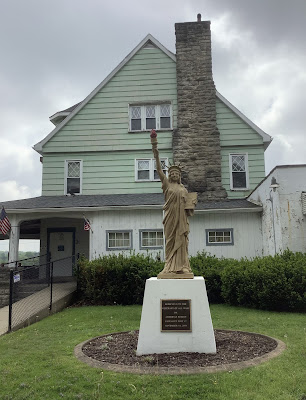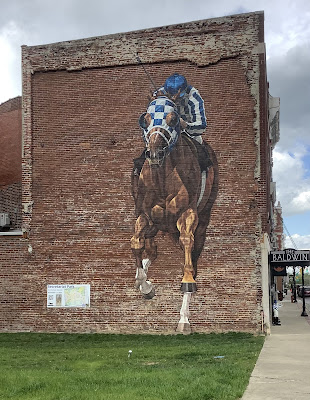My final night in a tent of these travels was spent at an actual campground, the first of my time away other than the initial two nights with Charlie in Nebraska by a prime sand hill crane nesting site. This was a primitive camping area with no water nor any sign-in necessary nor fee, just two designated spots and a portapotty.
I could have easily disappeared into the forest at many spots along the trail, but I was hoping for water to give myself a wash, and curious if there might be a community of cyclists at the campsite. All that was there in the parking lot was a father with three little, very excited girls preparing to go off for a few mile ride. I was happy to have a flat, well-groomed site to pitch my tent, especially after the previous night’s slender, uneven patch behind a complex of storage-lockers that necessitated clipping thorny bushes to slip behind.
It dates to 200 B. C. and originally had a moat around it and was part of a complex of other long-gone smaller mounds. It was saved by the Daughters of the American Revolution in 1908, as someone with a developer’s mentality bought it and wished to level it and sell lots, as it was valuable property in the middle of the town. The view from its summit peers down on a castle of a penitentiary modeled on that of the Joliet prison outside of Chicago. It dates to the Civil War and was in use up to 1995. It’s now a tourist attraction, especially popular at Halloween, as it’s reputedly haunted.
Departing the flat road along the Ohio, known as the Energy Road for all the petroleum processing plants along the way, my legs were put to a final test with the highest rate of feet gained per mile, over one hundred, of my time in the state. I was certainly striking a chord with West Virginians, as a motorist at a red light waiting to turn left let out a spontaneous shout at the sight of me saying, “Hey, way to go,” and a pedestrian blurted out as I passed, “My hero.” And there was the guy who called me the “Healthiest guy in all of West Virginian.” They were all older gents, perhaps beset by untold ailments that now limited their activity. Never have I received such accolades, as these folk understood it took no small effort to be bicycling the unrelenting mountainous terrain of their state.
I had to wait until I crossed into Pennsylvania, just a few miles away and came to the town of Avella Highlands to post my miles of the previous day on Strava and find out what was happening in the Giro, well into its first week. Its library was up a steep half mile road that had no traffic on it. I feared the library would have limited hours and this effort would be wasted. The library was in the community center and the librarian was out front walking a dog and smoking a cigarette. I was in luck, as the library was only open three days a week and only from ten to two.
I abandoned the bike path the next morning after two miles as it continued further north than I wanted to go. I chose a route through the town of Carnegie, established in 1894 and named for the steel magnate. Five years later it became the seventh community in the US to receive a library grant. It was built on a hill and had an adjoining music hall which receives much use. The library offered as comfortable a setting as any, a perfect place to while away a few hours as I had lots of time on my hands before my midnight train home.
At the entry to the town of eight thousand a plaque honored Honus Wagner, perhaps the greatest shortstop ever, who was born there and made it his home his entire life, as he played for the Pirates from 1900 to 1917. Mike Ditka was also born there in 1939, though he grew up in nearby Aliquippa, so he didn’t warrant a plaque.
With eight branch libraries, as well as the Main Library, scattered around Pittsburgh funded by Carnegie, it would have been difficult to avoid passing another. I had visited them all on previous visits to the city, but always welcome renewing acquaintances. I passed the West End branch shortly before the West End Bridge. It was the eighth library Carnegie funded in the US, opening in 1899. The West End Bridge took me over my old friend, the Ohio River, just after its origin from the merging of the Allegheny and Monogahela Rivers. It had become an unintended theme of these travels, as I’d also passed over a bridge at its terminus after its 981 mile meander into the Mississippi at Cairo, as well as biking along it for extended stretches in Kentucky and West Virginia.
It was the third library Carnegie funded in the US, opening in 1896. The library’s facade is ringed with a cavalcade of writers, artists, musicians and scientists—Homer, Herodotus, Cicero, Virgil, Chaucer, Tasso, Shakespeare, Jonson, Milton, Moliere, Pope, Voltaire, Goldsmith, Goethe’s, Scott, Irving, Macaulay, Longfellow, Emerson, Lowell, Thackeray, Dickens, Hawthorne, Tennyson, Copernicus, Galileo, Kepler, Newton, Leonardo, Raphael, Michaelangelo, Titian, Schumann, Gluck, Schubert, Mendelsohn, Haydn, Purcell, Palestrina, Rossini, Chopin, Rubinstein, Tschaikowsky, Govnody, Liszt and more.
And thus ends another glorious tour through seven states (Nebraska, Kansas, Missouri, Illinois, Kentucky, West Virginia and Pennsylvania), 3,686 miles in fifty-one days. I wove in over sixty Carnegies, forty-five that were new to me, bringing my life total to 1,115. That leaves me with 390 left to get to in the US, mostly in the northeast and northwest. I finished off four more states and nearly a fifth, with only three left in the northwest corner of Nebraska. My route intersected with thirteen Statue of Liberties in five of the states.
I will welcome some recovery days, as my legs were beginning to feel depleted. It took some effort to hike up the mound in Moundsville. But whenever I tried to sleep in, I couldn’t last beyond 7:30. I know my legs won’t let me take any days off, but it will be nice in the days to come to be pedaling an unladen bike and in the flatlands.



















































